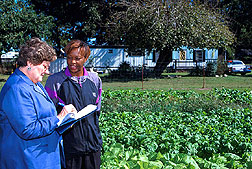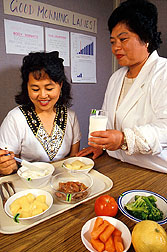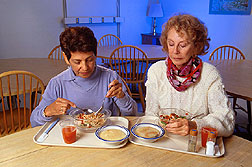Nutrition Research: Key To Eating Better
In the last century, scientists have probably learned more than at any other time in history about the dozens of nutrients our bodies require for growth and vitality. Not only have researchers in the still-young field of nutritional sciences discovered new essential vitamins and minerals, they have also found other intriguing compounds—like catechins in teas that neutralize cell damage from molecules known as oxygen free radicals.
While not ranked as essential, catechins and other little-known natural compounds may play other as-yet-undiscovered roles in enhancing our well-being.
Researchers have begun to harness the power of computers to model the way nutrients might work in our bodies. They have eagerly embraced sophisticated, leading-edge technologies such as supercritical fluid extraction and bioimpedance spectroscopy, among others, to speed their discoveries.
Here's a quick look at some of the hottest topics in ARS' nutrition research of the future.
Fighting Obesity
Despite our efforts to deal with increasingly sedentary lifestyles, Americans are, for the most part, getting fatter. Today, about one-third of all adults in this country are overweight or obese. A cost of $250 billion a year is estimated for medical treatment and lost productivity from obesity and increased risk for heart disease, stroke, high blood pressure, and some forms of cancer.
In response, Agricultural Research Service studies are, for example, defining new fat-to-lean ratios that can be used as healthful, realistic targets in weight-loss regimens. These ratios—an indicator of how much fat as compared with how much lean tissue, like muscle and water, make up our bodies—are thought to be a better indicator of health than either the weight ranges listed in the familiar height-weight tables or the current BMI index, a measurement of body mass. But well-researched ratios for people of all ages and ethnic groups don't yet exist. ARS nutrition researchers are tackling that job.
|
|
Other work targets how we use calories, or energy, that food provides. Once we know more about how our bodies burn calories, we will be better able to battle excess calories that the body stores as fat.
Obesity in our children and teens is of special concern, because an estimated one of every five kids in America today is overweight. Time spent watching TV, playing video games, or sitting at the computer contributes to the problem, as do the cutbacks in physical education programs at many schools. Childhood obesity has increased 50 percent in the past two decades and is considered a crisis because of the enormous impact expected on health-care costs in the new century.
ARS is intent on expanding research in this area, particularly with studies on how to influence kids' behavior so they will want to be more active and to eat nutritious foods.
ARS food technologists will continue to play a key role in helping our nation battle the bulge. Expect more innovations like the ARS family of Oatrim, Z-trim, and Nutrim products made from oats, barley, or corn.
These products, added to foods such as muffins, help cut calories without interfering with taste. And ARS plant scientists are working to boost the flavor and nutritional value of fruits and vegetables so these healthful foods will not only taste good, but will also deliver higher levels of nutrients than ever before.
Enriching Tomorrow's Foods—Naturally
In addition to essential vitamins and minerals, some plants provide natural compounds—called phytonutrients—that may help improve or protect our health. These include estrogenlike compounds called isoflavones that are found in soybeans and soy-based foods. Isoflavones may protect against heart disease and some cancers and may lower the artery-clogging LDL cholesterol.
Other phytonutrients, called thiols—in onions, garlic, olives, leeks, and other plants—also fight LDL cholesterol and may help keep our immune systems healthy.
Discoveries about these and other phytonutrients are reshaping nutrition research. In the past, the focus was on preventing nutrition-related deficiencies such as those that can lead to scurvy or rickets. Now we're moving toward analysis of whole foods and the beneficial phytonutrients they contain.
Our research will reveal more about how these compounds act in the body—and interact with each other. That should bring on a wider array of healthful food products enriched with these natural plant chemicals. ARS is now compiling information on the phytonutrient content of foods. The work will provide needed information for the agency's National Nutrient Database, the nation's premier source of information on nutrient content of fresh and processed foods.
We've already posted on the web a compilation of the isoflavones in more than 100 different soy-based foods. We conducted our own laboratory analyses of black teas to determine levels of antioxidant catechins. As more information becomes available, new listings of the levels of other phytonutrients will be added to the database.
Better Than RDAs
|
|
Since 1941, Recommend Dietary Allowances, or RDAs—those tiny-print numbers on the labels of your vitamin pill bottle or breakfast cereal box—have been our nation's most relied-on guidelines for our vitamin and mineral needs. Now they are being replaced.
The new, more detailed guidelines are called Dietary Reference Intakes. ARS is playing a lead role in providing detailed, reliable data used in setting new and appropriate DRIs for Americans of all ages. Our studies of vitamin K, for example, have shown that the long-standing recommended levels of this vitamin may be too low for optimal bone health. Our folate research was pivotal in helping increase the recommended intake of this essential B vitamin. What's more, ARS data are being used to help develop recommendations for a new category of DRI's known as "Tolerable Upper Intake Levels." These are the highest amount of a nutrient that can be safely consumed on a daily basis.
Though upper levels for some vitamins and minerals have been set, the scientific information needed to establish some others isn't yet available. New data from ARS may help fill those gaps.
Special Needs of Unique Groups
As America's diversity increases, so does the need for more and better information about the special nutrient needs of distinct populations—infants and children, pregnant and lactating women, ethnic groups such as Hispanic-Americans, African-Americans, and others.
Our study of African-American women living in the northeastern United States showed for the first time that they may not be making enough vitamin D from sunlight in summer to keep them well-supplied through winter.
Our collaborative studies of the nutritional needs of low-income families in the lower Mississippi Delta may serve as a model for similar efforts in other regions where infant mortality is high, birth weights are low, and nutrition-related chronic diseases exceed the national average.
These studies and others in progress will help move the nation closer to ensuring that Americans of all age, ethnic, and socio-economic groups are well nourished.
Spin-offs of Human Genome Research
|
|
Researchers worldwide have joined the quest to map the human genome; that is, to uncover the location, structure, and function of all the genes in the human body. They may reach their goal early in the new millennium. Nutrition research should benefit enormously from this venture.
The work will bolster our ongoing efforts to pinpoint genes that influence the risk of heart disease, for instance. Once these genes are known, we want to determine how genetic differences of individuals account for differences in their response to changes in diet, for example. That way, regimens to lower risk can be customized by genotype.
We have already identified several of the 40 or more genes known to influence cardiovascular health and have preliminary results from different diets designed to reduce LDL cholesterol.
Our research on genetic factors that increase the risk of osteoporosis will help healthcare professionals plan ways to reduce the painful and sometimes disfiguring spine, hip, and wrist fractures from this bone disease.
The roots of osteoporosis can begin in childhood. Children and teens with healthy bones have a lower risk of osteoporosis in later years. Our investigations of nutrition and bone health show that children with what is known as the "ff" form of the Fok1 gene absorb significantly less calcium—essential for healthy bones—than boys and girls with either of two other forms of this gene.
This work provides another piece of the puzzle of how our bodies absorb and use calcium. The healthfulness of some calcium-rich compounds has been known for centuries. But we are still trying to solve basic questions about how it behaves in our bodies.
"That's typical of the status of much nutrition research today. We have made great progress, but many basic questions remain unanswered," says Kathleen C. Ellwood. She is the ARS national program leader for human nutrition research.
"There is much to do and learn," Ellwood says. "We look forward to new decades of discovery that will enhance the well-being of all."—By Marcia Wood, Agricultural Research Service Information Staff.
To learn more about ARS' vision for Human Nutrition, an ARS National Program (#107), see the agency's World Wide Web page at http://www.nps.ars.usda.gov/programs/appvs.htm.
Kathleen C. Ellwood is with the USDA-ARS National Program Staff, 5601 Sunnyside Ave., Beltsville, MD 20705-5138; phone (301) 504-4675, fax (301) 504-5647.
"Nutrition Research: Key To Eating Better" was published in the December 1999 issue of Agricultural Research magazine.











